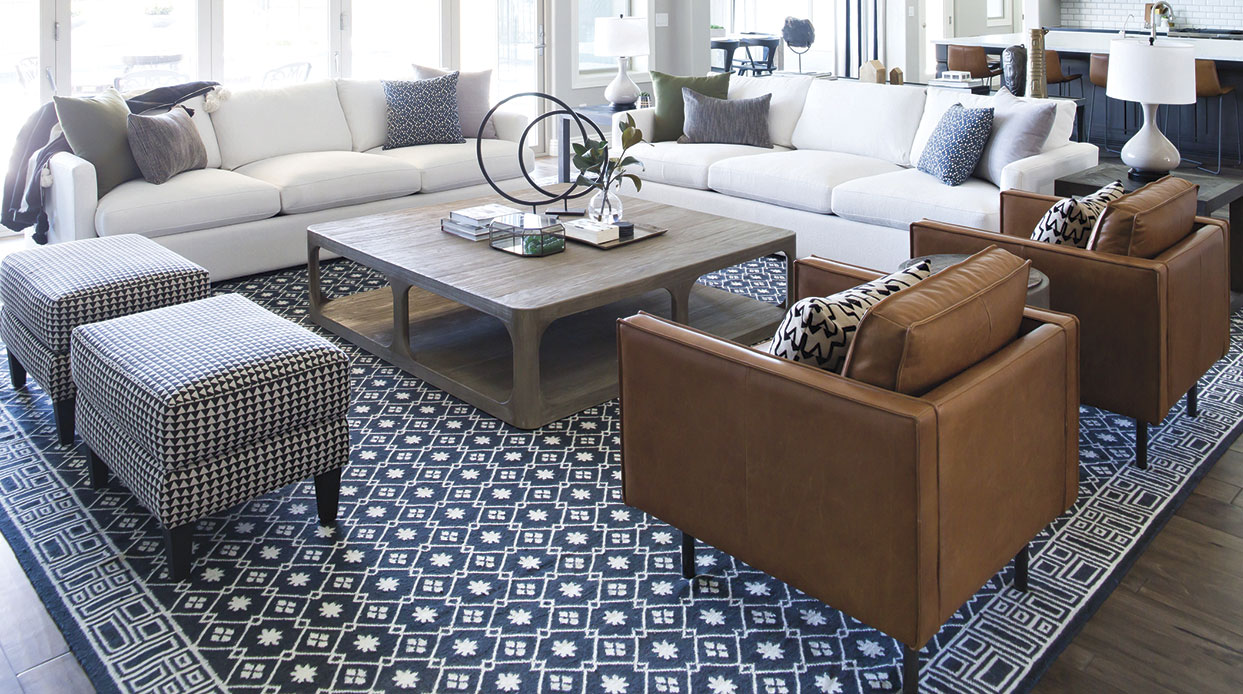Magnum Opus
2019 MASTERS of the SOUTHWEST Award Winner

A decade in the making, a contemporary courtyard abode is a study in the symbiotic relationship between nature, place and light.
By Rebecca L. Rhoades | Photography by Bill Timmerman
Legendary architect Frank Lloyd Wright once said, “Organic buildings are the strength and lightness of the spiders’ spinning—buildings qualified by light, bred by native character to environment, married to the ground.” His words allude to an intrinsic harmony between the manmade environment and Mother Nature, a notion universally desired by many architects but achieved by few.
In North Scottsdale, a 10,000-square-foot contemporary home of rammed earth, glass and steel—so complex in design that it took almost 10 years to build—nestles to perfection into its mountainous setting, maintaining a sense of simplicity and weightlessness. Constructed of the same earth on which it is built, it is an interplay of solid and void, open and closed, light and darkness—a bold monument of technology and design that appears to have simply grown from its rugged site.
This masterwork is the brainchild of architect Wendell Burnette. “The concept very early on was a solid form that’s cracked open to let in light and air while remaining secluded and serene,” he says. “It was about corralling a piece of the sky and creating privacy.”
In a development where “king-of-the-hill” homes with sweeping vistas of Valley lights are in high demand, the homeowners chose a lot at the base of a slope, surrounded on both sides by deep perennial washes and western views dominated by layers of distant mountain ranges. “We wanted to be down lower because we didn’t want to look at other structures,” says the homeowner. “Our missive to Wendell was, ‘Design a house where we can’t see any of our neighbors whatsoever.’ We wanted the best of both worlds—to live in a community with all the activities and amenities, but still have that feeling of being in a remote location.”
Architect Thamarit Suchart served as lead collaborator on the project. “The homeowners easily could have done a house at the top of the mountain, but they chose something that had much more character. When you don’t have an obvious focal point, you have to dig deeper to enrich the story. You have to analyze in depth what the site means, what opportunities you have, and which of the clients’ desires you are trying to bring forth to the equation. There was nothing simple or easy about this project.”

Burnette came up with a design based on “engawa.” A core element of traditional Japanese architecture, engawa, which literally translates to “edge side,” is an open patio or veranda that runs the length of the house. Often facing a courtyard, it carries the role of connecting the outside to the inside of the home. Another key aspect of engawa is a series of loosely defined rooms that open to the courtyard. Here, large glass walls in the master bedroom and main living areas pivot and pocket, providing a seamless flow between indoors and out. A long gallery spanning a wash connects the master and guest suites; its floor-to-ceiling windows and glass walkway visually bring the rocks and ground below into the interior space.
Outside, the house appears almost fortresslike. Rammed earth walls, some as thick as 3 feet and all fashioned from material excavated from the site, sit atop a concrete plinth that was cast in place. It’s sandblasted on the outside with a highly polished top that mimics the appearance of terrazzo. Throughout the earthen walls are “fissures,” or windows in a variety of custom configurations. “The material palette was very complicated,” notes builder Andy Byrnes. “The plinth is in a battered shape, which means it has a receding slope on the sides and is wider on the bottom, and the walls incorporate these unique conical windows.” A multitude of prototypes were required throughout the duration of the building process.
“I wanted to craft something that weathers and ages with dignity and has a certain quality that looks as good today as it will 20 or 50 years from now.”
––Wendell Burnette, architect
A weathered steel roof allows the home to recede into the shadows. “At first glance, you can’t even find the house,” says Burnette. Its mill-finished underside merges with the night sky. “We enjoy the darkness that is found outside the city. Unlike other folks, we’re not enamored with seeing a lot of lights,” notes the homeowner. A stainless steel plate above the dining table is punctuated with hundreds of pin lights. “It’s almost like the stars are coming through the ceiling,” he continues.
The use of earthen materials enhances the conversation between structure and landscape. “The homeowner liked to joke that his house was taking 10 years to build and is made of dirt and rust,” recalls the architect with a laugh. “But inside it is very detailed and nuanced, so there’s this juxtaposition between rough and refined; hard and soft; primal, elemental matter and very sophisticated materiality.”
A long drive through indigenous desert flora leads to the entrance on the eastern side of the home; the opening serves as the “hinge” of the cracked, fractured form. A frameless door, composed of the largest size glass made in the U.S., reveals the beginning of a triangular-shaped courtyard. A gnarled mesquite, bent at an almost 90-degree angle, dominates the apex. “You turn the corner and suddenly you’re in this space where everything is presented in front of you,” notes Suchart. “It’s choreographed in a way that heightens the overall experience.”
Wrapping around the northern side of the courtyard on the piano nobile are the living room, dining room and kitchen. Directly below are a powder room, media room and wine cellar. On the southern half of the home, the gallery bridge connects the master suite on the east with a study, library and guest suites to the west. The lower level sports a spa, art archives and a laundry room.
Glass walls open the upstairs to the courtyard. At the far end of the dining room, an oversized pane pivots open, providing access to a large patio, outdoor kitchen and what Burnette calls “the most honorific part of the plinth”—Arrow Rock. A massive boulder that points to the west, it was part of the original site and remained in place during construction. “The contractor suggested moving it and putting it back after we were completed, but we didn’t want to do that,” says Suchart. “It’s about respecting the site, as well as how do you least disturb something that’s been there, quite frankly, longer than this house ever will be.” Burnette added a fire feature along the rock’s flat side, turning it into main focal point of the design.

Also pivoting into the open air is a triangular-shaped leather sofa that cantilevers above the floor. Custom designed, like all the furniture throughout the house, by interior designers Craig Leavitt and Stephen Weaver, it features 0.5-inch-thick starfire edge lit glass backrests. “The idea is that you can look under or over this very large sofa to take in the views,” says Burnette. Adds the homeowner, “I’ve never seen anything like that before. Whoever buys this place when we’re gone isn’t going to take it out. It’s basically attached to a roof support.”
A highlight of the master bath is the backlit onyx shower wall. Because one of the homeowners’ many wants was an outdoor shower, the entire 1-ton wall, complete with controls and showerheads, swings outward into a private triangle-shaped terrace. Bronze wheels and a hydraulic assist allow the wall to easily open and close. “You push a lever and the whole wall opens up with the shower,” says Byrnes. A fire table and a lintel-less opening in the opposing rammed earth wall that looks out to the surrounding desert add to the patio’s tranquil atmosphere.
While every room and detail of the home tells a story, its most eye-catching feature is the glass gallery. Located across the courtyard from the living room, it houses the homeowners’ collection of vessels, ranging from 15th-century Dutch snuff boxes and Multhroup wood bowls to metalworks by Parisian artist Hervé Wahlen. The pieces are displayed on wenge shelving, finished with a highly reflective gloss. Floor-to-ceiling glass walls overlook the courtyard, while a glass walkway spans a wash. The 1.5-inch thick floor panes are tinted a soft green for ease of walkability. “If it was clear, it would be too scary,” says Suchart. “The hue gives a presence to the floor, but at the same time you get a sense that the earth is moving up inside of it.”
“On one side, you have rammed earth walls with very specific openings that home in on the landscape or particular vistas while editing out the neighbors. Inside, you have a crystalline courtyard that you want to look into.”
––Thamarit Suchart, lead architectural collaborator
In keeping with the home’s oneness with its surroundings, landscape designer Debra Dusenberry created a simple and desert-friendly garden, its minimalist palette appearing as though it was part of the undisturbed desert. Columbines, chuparosa, bursage and Agave parryi add texture and color to the natural grit that was removed prior to construction, stored off-site and reused in the completed landscape. Mesquite trees shelter the ground and allow dappled sunlight to filter in, warming the glass-enclosed rooms while protecting the precious artworks. “One of the main goals of the courtyard was to have plant material that would provide some shade and filtered screening as you’re walking through the house but not have such dense foliage that you couldn’t see through it at all,” she says.
Like Arrow Rock, a towering saguaro stood on the property. “I give Wendell and the homeowners credit for wanting to keep it in place,” says Dusenberry. “We built around it, and the fact that it’s still standing just shows you that we made a good decision.” A cluster of large volcanic rocks “that appear as though they have just fallen from the sky into the landscape,” according to Burnette, sits in the middle of a raised stabilized granite patio. Overall, the look is unpretentious and natural—a private Zen garden that maintains the integrity of the surrounding desert.
“From the outside, the house is kind of a bunker. You would never guess what’s inside,” says Burnette. “To me that says something about the desert. From a distance, it feels very impenetrable and harsh and not very hospitable. Yet when you’re walking in the desert and looking at the desert floor, there’s a delicacy and a richness of detail that is unexpected. It’s a fantastical landscape you don’t understand, and this house is kind of metaphorically related to that.”
For more information, see Sources.
2019 MASTERS of the SOUTHWEST Award Winner
Wendell Burnette
At age 13, Wendell Burnette already knew that he wanted to be an architect. At the public library in Nashville, Tennessee, where he grew up, he would study books about such greats as Le Corbusier, Ludwig Mies van der Rohe and, of course, Frank Lloyd Wright, whose love of nature the teen shared.
After graduating from high school, Wendell left his Southern home and traveled first north to Wisconsin and later to Arizona. “I spent my first summer at Taliesin and then came out here and lived in a tent at Taliesin West and immediately fell in love with the desert,” he says. “I was entranced by the openness and the light—really everything.” Following a two-year stint in Nashville, he returned to the Valley, where he ended up living in Paolo Soleri’s famed Dome in the Desert in Cave Creek—the very first building he emulated when he was 13—and found a job working with Phoenix Home & Garden Masters of the Southwest award-winning architect Will Bruder, a relationship that culminated with the design and building of the Burton Barr Central Library in Phoenix.
In 2006, Wendell founded his eponymous studio, Wendell Burnette Architects, and has been creating masterpieces that embrace the desert climate ever since. He’s known worldwide for designs that resonate with the power of their natural surroundings. “One great thing about Wendell is that he is able to balance the artistic side with the technical aspects. If he has an idea, he’s willing to push it to the max to see how it can be achieved and how it can be the best thing possible,” says architect Thamarit Suchart, who worked with our honoree for six and a half years. “The result is unprecedented pieces of architecture and design.”
For Wendell, there is no other option. “We’re all born with certain interests, and mine from a very early age was architecture,” he says, “yet my passion has always been nature and experiencing its spatial qualities. How we maintain those connections is important to our human psyche. It’s important to our well-being, to our souls.”
We agree. That’s why we’re naming the visionary architect a Phoenix Home & Garden Masters of the Southwest award winner. Congratulations, Wendell. —The Editors





















